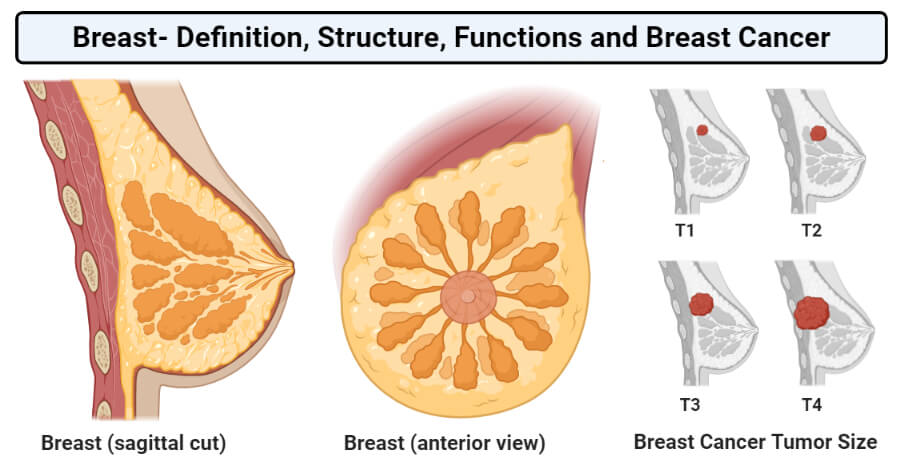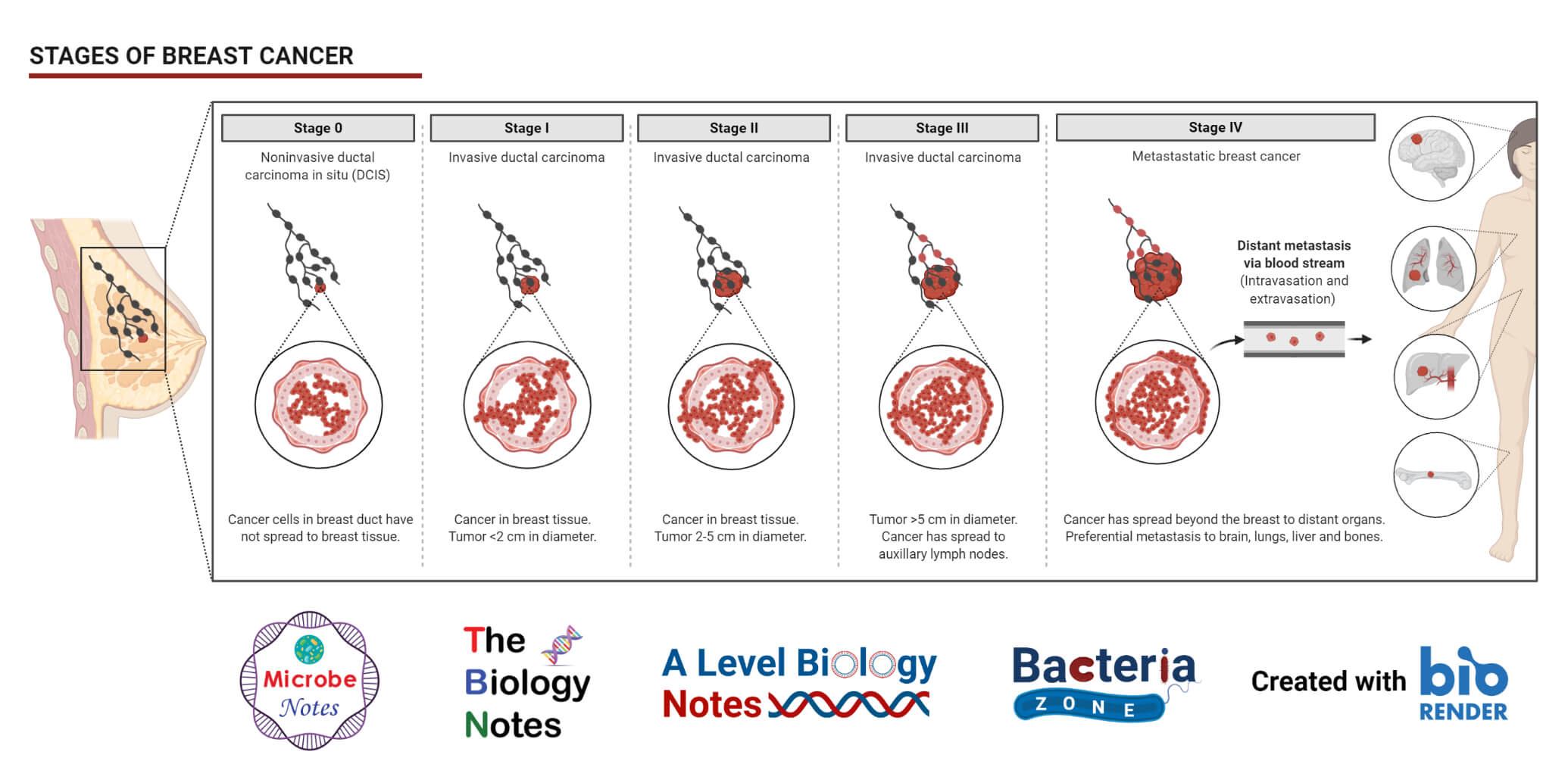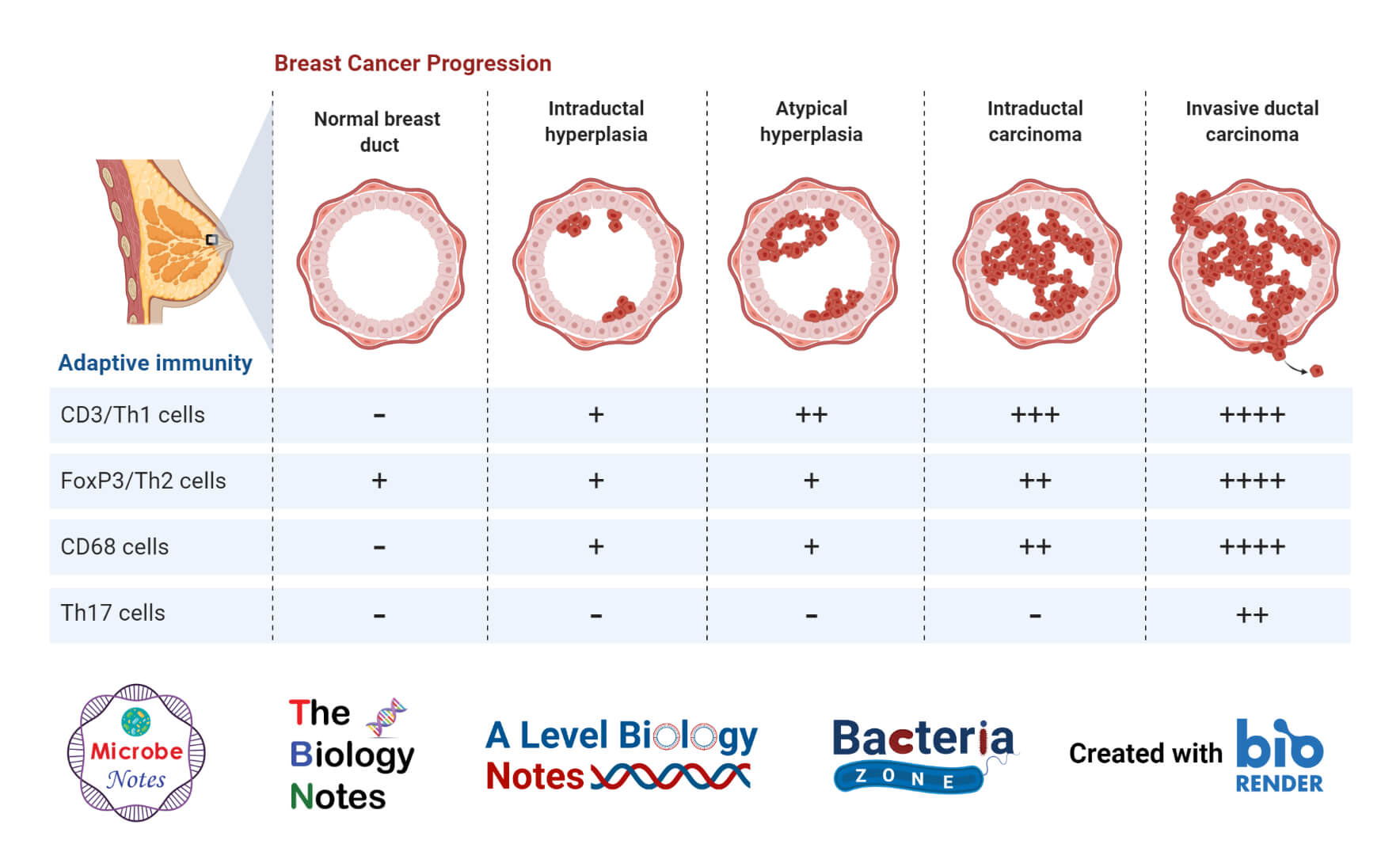Breasts or mammary glands are a pair of structures present in the thoracic region of primates. These glands are present in both the male and female primates, but in males, these structures remain rudimentary.
- Breasts are the accessory glands of the female reproductive system responsible for the lactation of a newly born child, among other functions.
- In humans, breasts develop at puberty by the action of growth hormone and estrogen; however, in other primates, breast development usually happens after the pregnancy.
- After the birth of the baby, the hormone prolactin from the anterior pituitary stimulates the production of milk in the breasts, and the hormone oxytocin from the posterior pituitary stimulates the release of milk on stimulation of nipples by the sucking baby.
Interesting Science Videos
Structure of Breast
- Structurally, breasts are tear-shaped and are composed of glandular tissue, fibrous tissue, fatty tissue, and blood supply.
- The size of breasts varies among women with an average weight of 500 grams or less. The tissue composition of breasts also varies among women, which determines the firmness or density of the breasts.
- The shape, size, and weight of the breasts changes in women in different stages of life like puberty, menstrual cycle, pregnancy, breastfeeding, and menopause.
- An adult female breast consists of around 20 lobes of glandular tissue where each lobe is made up of several lobules that radiate around the nipple.
- Each of these lobules is composed of a group of alveoli that terminate into small ducts, which collectively form large excretory ducts called lactiferous ducts.
- These ducts, supported by the dense connective tissues, converge towards the center of the breasts to form reservoirs (also called lactiferous sinus) of milk. From each of these sinuses, a single duct arises that opens into the nipple.
- Various arteries, veins, and lymph nodes provide blood and lymph supply to the breasts. The network of connective tissue and ligaments provide support and shape to the glands.
The nipple
- The nipple is a conical protrusion present at the center of the breast surrounded by a pigmented area of skin, called the areola.
- The areola is provided with modified sebaceous glands, called Montgomery glands, which secrete an oily fluid that helps lubricate and protect the nipple during lactation.
- Different volatile compounds present in the fluid provide olfactory stimulation to the new born’s appetite.

Functions of Breast
- The primary function of breasts is to provide nourishment to the infant through breastfeeding. When an infant sucks on the mother’s nipples, the mother’s brain secretes oxytocin. A prominent level of oxytocin triggers the contraction of cells surrounding the alveoli, which causes the release of milk through the duct to the nipples.
- In addition to their primary function of providing nutrients to the infant, breasts also have social and sexual prominence. These structures are often considered as a measure of sexual attractiveness in women.
- Breasts, and especially the nipples, are an erogenous zone.
Composition of breast milk
- At the peak of lactation, an adult female can produce about 1.2 liters of milk every day and even more in the case of twins.
- Human milk consists of 88.5% of water, 3.3% fat, 6.8% lactose, 0.9% casein, 0.4% lactalbumin and other proteins and 0.2% ash. About 650-700 kilocalories per liter of energy is present in human milk.
- Besides the necessary nutrients, human milk also protects against various infections. Multiple types of antibodies are secreted with the milk that protects against several lethal microbes. White blood cells like neutrophils and macrophages are also found in human milk.
Breast Cancer
Breast cancer is the most common cancer in women in both developed and less developed countries and the second most common cancer overall. The incidence of breast cancer has increased by more than 20% worldwide since 2008 and the mortality rate has increased by 14%. Breast cancer is cancer that develops in the breasts when the cells divide out of control. Most commonly, breast cancer begins in the lactiferous ducts that carry milk to the nipple, followed by cancer in the glands that make the milk.

Figure: Breast cancer stages are expressed as a number on a scale of 0 through IV based on size, localization, and invasiveness, with stage 0 describing localized and non-invasive cancers and stage IV describing invasive cancers that have spread outside the breast to other parts of the body. Organ-specific metastasis, namely to the brain, lungs, liver, and bones, is characteristic of metastatic breast cancers. Image Created with BioRender.com.
Tumors in the breasts can be observed to be of two types:
a. Benign Tumors
- Most of the breast tumors (about 90%) are benign. These are usually non-cancerous and do not spread out of the organ; however, these tumors increase the risk of getting breast cancer so they should be regularly checked.
- These tumors might occur any time after puberty, but the peak usually occurs in the women approaching menopause. Some are cystic while some are solid.
- They might originate from either the fibrous tissue or from the milk-carrying ducts.
b. Malignant Tumors
- Malignant tumors are present as painless lumps in the upper quadrant of the breast. Significant fibrosis is observed around the tumor that might cause retraction of the nipple, necrosis of skin, or ulceration of underlying surfaces.
- Other signs of breast cancer include the formation of lumps, change in the shape of the breast, dimpling of the skin, and yellowish watery fluid from the breast.
- A malignant tumor is common in women aged between 35-70 years.
- This type of tumor might spread to other organs than the breast via lymph to the axillary and internal nodes in the mammary glands. Blood spread metastases may be observed later in bones of the vertebrae.
- The leading cause behind the cancer is not yet known; however, prolonged exposure to the hormone, estrogen, is considered a major risk factor.
- As women with early menarche, late menopause, and no pregnancies observe more menstrual cycles in their lifetime, the exposure to estrogen also increases. Thus, these women are exposed to more risk than usual.
- The genetic transfer is also likely as the close relatives of cancer patients carrying BRCA1 and BRCA2 genes tend to be at high risk of getting the disease.
- Other risk factors include the consumption of alcohol and tobacco, which increases the risk by 30-50%. Lack of physical exercise and dietary habits, including high fat and high cholesterol level is also associated with an increased risk of breast cancer.
- Diagnosis of a malignant tumor is commonly performed by taking a biopsy of the affected tissue. Once the diagnosis is confirmed, other tests are performed to observe if cancer has spread to other parts of the body.

Figure: Adaptive Immunity During Breast Cancer Progression. Image Created with BioRender.com.
References and Sources
- Hall JE and Guyton AC. (2011) Textbook of Medical Physiology. Twelfth Edition. Elsevier Saunders.
- Waugh A and Grant A. (2004) Anatomy and Physiology. Ninth Edition. Churchill Livingstone.
- Marieb EN and Hoehn K. (2013) Human Anatomy and Physiology. Ninth Edition. Pearson Education, Inc.
- Wu G, Bazer FW, Cudd TA, et al.: Maternal nutrition and fetal development, J Nutr 134:2169, 2004.
- 12% – Integumentary System- definition, organs, functions, diseases
- 2% – https://www.bcrf.org/breast-cancer-statistics-and-resources
- 1% – https://www.webmd.com/cancer/understanding-cancer-treatment
- 1% – https://www.toppr.com/guides/biology/human-reproduction/female-reproductive-system/
- 1% – https://www.cdc.gov/cancer/breast/basic_info/symptoms.htm
- 1% – https://www.cancer.org/cancer/thyroid-cancer/causes-risks-prevention/what-causes.html
- 1% – https://www.cancer.net/navigating-cancer-care/prevention-and-healthy-living/obesity-weight-and-cancer-risk
- 1% – https://quizlet.com/95674535/arteries-veins-and-lymph-nodes-of-the-thoracic-limb-flash-cards/
- 1% – https://healthjade.net/breast-cancer/
- 1% – https://biology.reachingfordreams.com/biology/endocrine-system/12-anterior-and-posterior-pituitary-gland-hormones-and-their-functions
- <1% – https://www.sciencedirect.com/science/article/pii/S030881460900137X
- <1% – https://www.rnpedia.com/nursing-notes/medical-surgical-nursing-notes/mammary-glands-breast/
- <1% – https://www.newhealthadvisor.org/breast-cancer-in-lymph-nodes.html
- <1% – https://www.healthline.com/health/montgomerys-tubercles
- <1% – https://www.healthhype.com/breast-tumors-benign-and-malignant-different-types-diagnosis.html
- <1% – https://www.cdc.gov/genomics/disease/breast_ovarian_cancer/genes_hboc.htm
- <1% – https://quizlet.com/118214434/breast-feeding-flash-cards/
